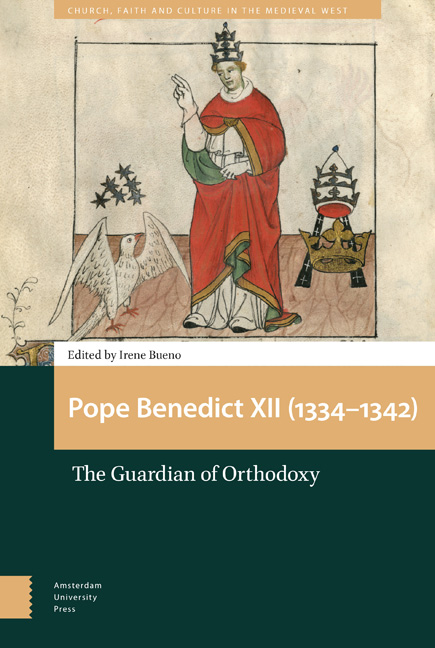Book contents
- Frontmatter
- Contents
- Abbreviations
- List of Illustrations
- Introduction: Benedict XII, the Guardian of Orthodoxy
- 1 Jacques Fournier and Thirteenth-Century Inquisitorial Methods
- 2 Recovering a Theological Advice by Jacques Fournier
- 3 Benedict XII and the Beatific Vision
- 4 A New Seat for the Papacy: Benedict XII, Avignon, and the Comtat Venaissin
- 5 In the Footsteps of St Peter: New Light on the Half-Length Images of Benedict XII by Paolo da Siena and Boniface VIII by Arnolfo di Cambio in Old St Peter’s
- 6 Benedict XII and Italy: Restoring Orthodoxy and Consolidating Papal Sovereignty after John XXII
- 7 Benedict XII and the Outbreak of the Hundred Years’ War
- 8 Benedict XII and the Crusades
- 9 Benedict XII and the Partes Orientis
- Index of Names
- Index of Subjects
8 - Benedict XII and the Crusades
Published online by Cambridge University Press: 11 December 2020
- Frontmatter
- Contents
- Abbreviations
- List of Illustrations
- Introduction: Benedict XII, the Guardian of Orthodoxy
- 1 Jacques Fournier and Thirteenth-Century Inquisitorial Methods
- 2 Recovering a Theological Advice by Jacques Fournier
- 3 Benedict XII and the Beatific Vision
- 4 A New Seat for the Papacy: Benedict XII, Avignon, and the Comtat Venaissin
- 5 In the Footsteps of St Peter: New Light on the Half-Length Images of Benedict XII by Paolo da Siena and Boniface VIII by Arnolfo di Cambio in Old St Peter’s
- 6 Benedict XII and Italy: Restoring Orthodoxy and Consolidating Papal Sovereignty after John XXII
- 7 Benedict XII and the Outbreak of the Hundred Years’ War
- 8 Benedict XII and the Crusades
- 9 Benedict XII and the Partes Orientis
- Index of Names
- Index of Subjects
Summary
Abstract
This chapter analyses the crusading policy of Benedict XII in regard to the Eastern Mediterranean, Iberia, and north-eastern Europe. It explores the implementation and withholding of papal crusading mechanisms by the pope – such as preaching, indulgences, and tithes – as well as the negotiations that he instigated in an attempt to form Christian alliances against Muslims in the East, all of which come under the wider umbrella of crusading during the period. The chapter concludes by addressing the effect which Benedict's pontificate had on shaping wider crusading strategy during the fourteenth century.
Keywords: Papacy, crusades, Turks, Byzantines, Venice, Hospitallers, Benedict XII
During the fourteenth century the Eastern Mediterranean underwent a dramatic political and religious transformation. The Mamluk sultanate of Egypt maintained control of the Holy Land and the southern Levantine regions, but in Asia Minor, Greece, and the Balkans the rising Anatolian Turkish principalities began to replace previous Byzantine, Frankish, and Serbo-Bulgarian domination. In this century, the planning and launching of a crusade to the East changed in accordance with this new reality, both in terms of who initiated a crusade and against whom one was aimed. Although a desire to liberate Jerusalem never died out, it is safe to say that the fourteenth century witnessed a change in crusade impetus, as proposals to defend Christian territories from Turkish advances came to dominate crusading strategy. In other theatres too, great changes were underfoot during this period. In Iberia the kingdoms of Castile, Aragon-Catalonia, and Portugal gradually pushed the Moors from all but the southernmost regions of the peninsula, and in north-eastern Europe the Catholic rulers launched increasingly successful campaigns to convert and subject the Lithuanians and other Baltic peoples, as well as to defend their territories from Tartar incursions.
The pontificate of Benedict XII was sandwiched between two of the most active crusading popes of the century, John XXII (1316–1334) and Clement VI (1342–1352). Their dedication to the crusade was characterized by a vigorous response to the Turkish threat, reflected by two of the most significant crusading enterprises of the period: the naval league launched in the Aegean in 1333–1334, and the crusade of Smyrna in 1343–1352.
- Type
- Chapter
- Information
- Pope Benedict XII (1334–1342)The Guardian of Orthodoxy, pp. 217 - 240Publisher: Amsterdam University PressPrint publication year: 2018



